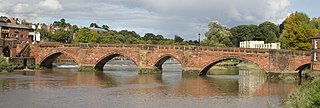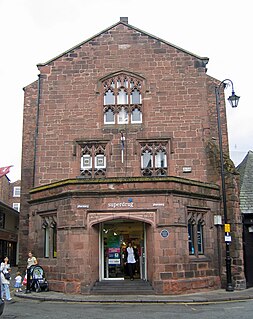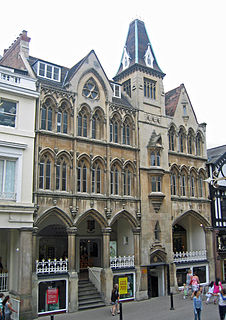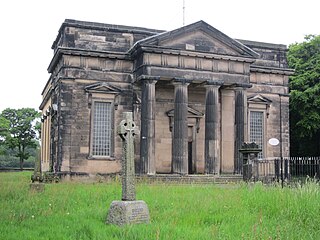
Chester Castle is in the city of Chester, Cheshire, England. It is sited at the southwest extremity of the area bounded by the city walls. The castle stands on an eminence overlooking the River Dee. In the castle complex are the remaining parts of the medieval castle together with the neoclassical buildings designed by Thomas Harrison which were built between 1788 and 1813. Parts of the neoclassical buildings are used today as Crown Courts and as a military museum. The museum and the medieval remains are a tourist attraction.

Thomas Harrison was an English architect and bridge engineer who trained in Rome, where he studied classical architecture. Returning to England, he won the competition in 1782 for the design of Skerton Bridge in Lancaster. After moving to Lancaster he worked on local buildings, received commissions for further bridges, and designed country houses in Scotland. In 1786 Harrison was asked to design new buildings within the grounds of Lancaster and Chester castles, projects that occupied him, together with other works, until 1815. On both sites he created accommodation for prisoners, law courts, and a shire hall, while working on various other public buildings, gentlemen's clubs, churches, houses, and monuments elsewhere. His final major commission was for the design of Grosvenor Bridge in Chester.

The Old Dee Bridge in Chester, Cheshire, England, is the oldest bridge in the city. It crosses the River Dee carrying the road that leads from the bottom of Lower Bridge Street and the Bridgegate to Handbridge. A bridge on this site was first built in the Roman era, and the present bridge is largely the result of a major rebuilding in 1387. It is recorded in the National Heritage List for England as a designated Grade I listed building, and is a scheduled monument.

St Peter's Church is in Chapel Street, Congleton, Cheshire, England. It is recorded in the National Heritage List for England as a designated Grade I listed building. It is an active Anglican parish church in the Diocese of Chester, the archdeaconry of Macclesfield and the deanery of Congleton. Its benefice is combined with those of St Stephen, Congleton, St John the Evangelist, Buglawton, and Holy Trinity, Mossley. Alec Clifton-Taylor includes it in his list of 'best' English parish churches. The Church Buildings Council included St Peter`s in its group of 300 Major Parish Churches following research produced in 2016. [Pursell 2016]

St Nicholas Chapel is a former chapel in St Werburgh Street, Chester, Cheshire, England. Since it ceased functioning as a chapel it has had a number of uses, including being at one time a theatre. It is now used as a shop. It is recorded in the National Heritage List for England as a designated Grade II listed building, and is a scheduled monument.

St Paul's Church overlooks the River Dee in Boughton, Chester, Cheshire, England. The church is recorded in the National Heritage List for England as a designated Grade II* listed building, and, before its closure, was an Anglican parish church in the diocese of Chester, the archdeaconry of Chester and the deanery of Chester. In the series Buildings of England, the architectural historian Nikolaus Pevsner stated that he regarded it as "the boldest of Douglas' church designs".

The Northgate is in Chester, Cheshire, England, where it carries the city walls footpath over Northgate Street. It is recorded in the National Heritage List for England as a designated Grade I listed building.

Walmoor Hill is a large house in an elevated position overlooking the River Dee on the west side of Dee Banks, Chester, Cheshire, England. It is recorded in the National Heritage List for England as a designated Grade II* listed building. The authors of the Buildings of England series describe it as a "house of considerable size and panache".

Davenham Hall is a former country house to the southeast of the village of Davenham, Cheshire, England. It was built for Thomas Ravenscroft to replace a timber-framed house called Davenham Lodge. It dates from the middle or the later part of the 18th century, possibly from shortly before 1795, when Ravenscroft died. Substantial additions were made in the early 19th century. It is constructed in stuccoed brick, and has a slate roof. The house is in two storeys with a symmetrical entrance front of six bays. Occupying the middle two bays is a porch with four Tuscan columns and an entablature containing a triglyph. Above this, the central bays protrude slightly forwards and contain two windows, with a pediment above them and a parapet on each side. Figueirdo and Treuherz describe the interior as being "especially fine". The entrance hall contains Grecian plasterwork and a black marble chimneypiece. The drawing room has more delicate plasterwork, and a marble chimneypiece decorated with dancing figures. The central staircase hall is lit by a central dome, and has fan-shaped plasterwork. The staircase has a wrought iron baluster, and the first floor landing has a screen of four Doric columns. The house was converted into a nursing home in 1980. It is recorded in the National Heritage List for England as a designated Grade II* listed building.
Oughtrington Hall was a country house located in Oughtrington Lane to the east of the village of Lymm in Cheshire, England.

The former Chester Royal Infirmary is in City Walls Road, Chester, Cheshire, England. The original hospital building is recorded in the National Heritage List for England as a designated Grade II listed building.

Watergate House is in Watergate Street, Chester, Cheshire, England. It is recorded in the National Heritage List for England as a designated Grade II* listed building.

Thomas Mainwaring Penson (1818–64) was an English surveyor and architect. His father and grandfather, who were both named Thomas Penson, were also surveyors and architects. His grandfather Thomas Penson worked from an office in Wrexham, North Wales, and was responsible for the design of bridges, roads, gaols and buildings in North Wales. His son Thomas Penson (1790–1859) was county surveyor to a number of Welsh counties and also designed bridges. He later moved to Oswestry, Shropshire where he established an architectural practice. Thomas Mainwaring Penson was born in Oswestry, and was educated at Oswestry School. His elder brother was Richard Kyrke Penson who became a partner in the Oswestry practice in 1854, before developing an extensive architectural practice of his own, mainly in South Wales. Thomas Mainwaring Penson trained in his father's practice. Thomas Mainwaring initially designed buildings in the area of the practice, including stations for the Shrewsbury and Chester Railway.

The Wesley Methodist Church is in St John Street, Chester, Cheshire, England. It is an active Methodist church in the circuit of Chester. The church is recorded in the National Heritage List for England as a designated Grade II listed building.

The English Presbyterian Church of Wales is in City Road, Chester, Cheshire, England. The church was built in 1864, and designed by Michael Gummow of Wrexham. It is constructed with a stuccoed front and brick sides, and has a slate roof. The architectural style is Neoclassical, Its entrance front is in five bays; it has a portico with four Ionic columns, and a three-bay pediment. The opposite end of the church is apsidal. The church is recorded in the National Heritage List for England as a designated Grade listed building.

The Welsh Presbyterian Church is in St John Street, Chester, Cheshire, England. The church was built in 1866, and designed by W. & G. Audsley of Liverpool. It is constructed with a yellow sandstone front, brick sides and rear, and a slate roof. The plan consists of a simple rectangle, with an apse at the east end, and a narrower single-storey narthex at the west (entrance) end. The narthex is supported by octagonal piers at the corners and two granite columns between them. On each side of the narthex is a lancet window. Above the narthex is a large rose window, with a lancet window above, and a cross finial on the gable. The church is recorded in the National Heritage List for England as a designated Grade II listed building. The wall and the iron railings and gates in front of the church are included in the listing.

Uffington House is in Dee Hills Park, Chester, Cheshire, England. It was built in 1885 for Thomas Hughes, the author of Tom Brown's School Days, and designed by Edward Ould. It is constructed in red brick with stone and terracotta dressings and a red tile roof. The house is in three storeys with cellars and an attic. Its architectural features include turrets surmounted by spires with lead finials. The house is recorded in the National Heritage List for England as a designated Grade II listed building.

St John's Church is in Liscard Road, Egremont, Merseyside, England. It is a redundant Anglican parish church, formerly in the diocese of Chester. The church is recorded in the National Heritage List for England as a designated Grade II listed building.

















